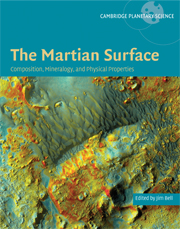Book contents
- Frontmatter
- Contents
- List of contributors
- Foreword
- Acknowledgments
- Part I Introduction and historical perspective
- Part II Elemental Composition: Orbital and in situ Surface Measurements
- Part III Mineralogy and Remote Sensing of Rocks, Soil, Dust, and Ices
- 7 Mineralogy of the Martian surface from Mars Express OMEGA observations
- 8 Visible to near-IR multispectral orbital observations of Mars
- 9 Global mineralogy mapped from the Mars Global Surveyor Thermal Emission Spectrometer
- 10 The compositional diversity and physical properties mapped from the Mars Odyssey Thermal Emission Imaging System
- 11 Mars' crustal magnetization: a window into the past
- 12 Multispectral imaging from Mars Pathfinder
- 13 Mars Exploration Rover Pancam multispectral imaging of rocks, soils, and dust at Gusev crater and Meridiani Planum
- 14 The mineralogy of Gusev crater and Meridiani Planum derived from the Miniature Thermal Emission Spectrometers on the Spirit and Opportunity rovers
- 15 Iron mineralogy and aqueous alteration on Mars from the MER Mössbauer spectrometers
- 16 Magnetic properties of Martian surface materials
- 17 Martian meteorites as crustal samples
- Part IV Physical Properties of Surface Materials
- Part V Synthesis
- Part VI Summary, Upcoming Missions, and New Measurement Needs
- Index
- Plate section
- References
11 - Mars' crustal magnetization: a window into the past
from Part III - Mineralogy and Remote Sensing of Rocks, Soil, Dust, and Ices
Published online by Cambridge University Press: 10 December 2009
- Frontmatter
- Contents
- List of contributors
- Foreword
- Acknowledgments
- Part I Introduction and historical perspective
- Part II Elemental Composition: Orbital and in situ Surface Measurements
- Part III Mineralogy and Remote Sensing of Rocks, Soil, Dust, and Ices
- 7 Mineralogy of the Martian surface from Mars Express OMEGA observations
- 8 Visible to near-IR multispectral orbital observations of Mars
- 9 Global mineralogy mapped from the Mars Global Surveyor Thermal Emission Spectrometer
- 10 The compositional diversity and physical properties mapped from the Mars Odyssey Thermal Emission Imaging System
- 11 Mars' crustal magnetization: a window into the past
- 12 Multispectral imaging from Mars Pathfinder
- 13 Mars Exploration Rover Pancam multispectral imaging of rocks, soils, and dust at Gusev crater and Meridiani Planum
- 14 The mineralogy of Gusev crater and Meridiani Planum derived from the Miniature Thermal Emission Spectrometers on the Spirit and Opportunity rovers
- 15 Iron mineralogy and aqueous alteration on Mars from the MER Mössbauer spectrometers
- 16 Magnetic properties of Martian surface materials
- 17 Martian meteorites as crustal samples
- Part IV Physical Properties of Surface Materials
- Part V Synthesis
- Part VI Summary, Upcoming Missions, and New Measurement Needs
- Index
- Plate section
- References
Summary
ABSTRACT
Mars Global Surveyor (MGS) discovered intense magnetization in the Mars crust. The planet, which today lacks a dynamo, somehow acquired a crust with at least 10, and perhaps as much as 100 times the volume magnetization intensity of Earth's crust. Interpretation of these data has provided a new and unique window into the origin and evolution of the planet. In this chapter we consider the implications of these discoveries for the understanding of processes that may have led to the minerals and geology that are observed on Mars' surface today. We also include relevant work associated with Earth's magnetic minerals and magnetic and mineralogical characteristics of SNC (SNC – Shergottite, Nakhlite, and Chassignite) meteorites. There is widespread agreement that the Martian dynamo ceased operation within < 500 Myr of accretion and core formation, exposing the atmosphere to erosion by ion-pickup processes in the solar wind for > 4 Gyr. This may constitute an important additional constraint on the minerals and geochemistry observed to date. There is less agreement on whether the magnetic record requires an early era of plate tectonics on Mars. A complete understanding of the crustal magnetic record remains as one of the most significant challenges in Martian geophysical research, one with great potential for understanding not only Mars' evolution but also many aspects of that of the terrestrial planets, asteroids, and the Moon.
- Type
- Chapter
- Information
- The Martian SurfaceComposition, Mineralogy and Physical Properties, pp. 242 - 262Publisher: Cambridge University PressPrint publication year: 2008
References
- 11
- Cited by

